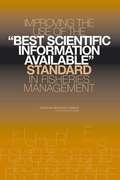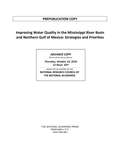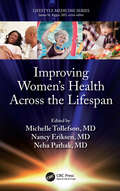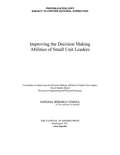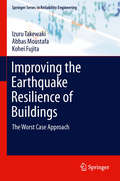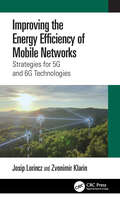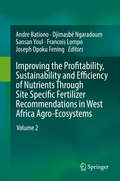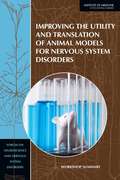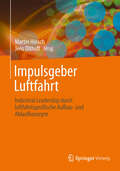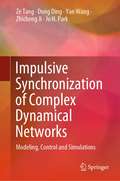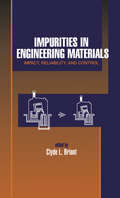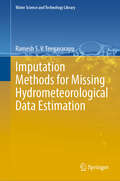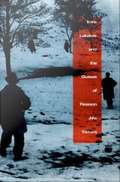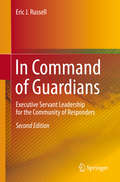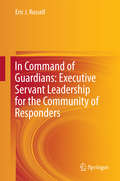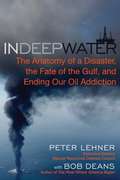- Table View
- List View
Improving The Use Of The "best Scientific Information Available" Standard In Fisheries Management
by Committee on Defining Best Scientific Information Available for Fisheries ManagementUnder the Magnuson-Stevens Fisheries Conservation and Management Act (FCMA), managers are required to use the “best scientific information available” in the preparation of federal fishery management plans (National Standard 2 in the FCMA). However, the Act provides no further guidance as to how conformance to this standard should be determined. Because adherence to this standard has often been contentious, Congress has considered adding a definition for what constitutes “best scientific information available” in the reauthorization of the FCMA. This report examines both the current application and the controversy over the standard and concludes that a legislative definition would be too inflexible to accommodate regional differences and future advances in science and technology. Instead, the report recommends that NOAA Fisheries adopt procedural guidelines to ensure that the scientific information used in the development of fishery management plans is relevant and timely and is the product of processes characterized by inclusiveness, transparency and openness, timeliness, and peer review.
Improving Water Quality in the Mississippi River Basin and Northern Gulf of Mexico: Strategies and Priorities
by Committee on Clean Water Act Implementation Across the Mississippi River BasinMost water resources managers, scientists, and other experts would agree that nonpoint source pollution is a more pressing and challenging national water quality problem today than point source pollution. Nonpoint sources of pollutants include parking lots, farm fields, forests, or any source not from a discrete conveyance such as a pipe or canal. Of particular concern across the Mississippi River basin (MRB) are high levels of nutrient loadings--nitrogen and phosphorus--from both nonpoint and point sources that ultimately are discharged into the northern Gulf of Mexico (NGOM). Nutrients emanate from both point and nonpoint sources across the river basin, but the large majority of nutrient yields across the MRB are nonpoint in nature and are associated with agricultural activities, especially applications of nitrogen-based fertilizers and runoff from concentrated animal feeding operations. Improving Water Quality in the Mississippi River Basin and Northern Gulf of Mexico offers strategic advice and priorities for addressing MRB and NGOM water quality management and improvements. Although there is considerable uncertainty as to whether national water quality goals can be fully realized without some fundamental changes to the CWA, there is general agreement that significant progress can be made under existing statutory authority and budgetary processes. This book includes four sections identifying priority areas and offering recommendations to EPA and others regarding priority actions for Clean Water Act implementation across the Mississippi River basin. These sections are: USDA's Mississippi River Basin Healthy Watersheds Initiative; Numeric Water Quality Criteria for the northern Gulf of Mexico; A Basinwide Strategy for Nutrient Management and Water Quality; and, Stronger Leadership and Collaboration.
Improving Women’s Health Across the Lifespan (Lifestyle Medicine)
by Michelle Md, Michelle TollefsonThere is renewed interest in lifestyle medicine – the focus on food, physical activity, stress management, high-quality connections, restorative sleep, and avoidance of toxic substances – in the prevention, treatment, and sometimes reversal of chronic disease, but very little information exists on its application for improving specific women’s health issues across the lifespan. Consequently, there is a growing need among health professionals who care for women for a textbook that addresses evidence-based lifestyle solutions to manage the health challenges they face every day in their offices. This book begins with a review of the fundamentals of Lifestyle Medicine through the lens of a woman’s lifespan. It provides information about lifestyle interventions to improve gynecologic and sexual health and to manage and sometimes reverse gynecologic diseases. It clarifies the importance of lifestyle and behaviors before and during pregnancy to address infertility, reduce adverse pregnancy outcomes, and to lower non-communicable diseases in children along with emerging epigenetic evidence. The use of Lifestyle Medicine to prevent and manage breast and gynecologic cancers, enhance health as part of cancer survivorship, and decrease the risk or reduce many of the symptoms and diseases experienced during menopause including vasomotor symptoms and osteoporosis are also discussed. Additionally, the text covers cardiovascular disease, diabetes, autoimmune disorders, dementia and mental health from the perspective of gender specific differences. This book provides practical resources on implementing the components of lifestyle medicine. Some of the topics covered include models of care for women and families, reimbursement, health coaching and behavioral change, community engagement and health equity for under-resourced settings. The electronic version of the book presents supplemental material featuring in-depth reading, as well as online and digital resources for implementing Lifestyle Medicine. The book is an evidence-based source of information on women’s health issues for health professionals already practicing lifestyle medicine, as well as an entry level textbook for those new to the field of lifestyle medicine. The collective expertise of each of the editors along with content provided by leaders within the American College of Lifestyle Medicine fills a much-needed void within the specialty of Lifestyle Medicine and is for providers of women’s health globally. Features: ● Provides a basic overview of Lifestyle Medicine (nutrient-rich diet, exercise, stress resilience, sleep, and high-quality connections) in the care of women across the lifespan. ● Provides lifestyle-focused treatment recommendations for specific women health issues. ● Includes strategies for implementing Lifestyle Medicine with vulnerable populations and in communities. ● Summarizes key points at the close of each chapter and includes supplemental material with in-depth reading. ● Features additional resources for implementing lifestyle medicine into practice. "This women's health book is evidence based and comprehensive. There is nothing like it. Women need up to date information about physical activity, nutrition, sleep, stress resilience, social connection and substance use. In addition, there is a desire to better understand the power of these pillars throughout a woman's life including pregnancy, menopause and the golden years. This book fills that need." Elizabeth Pegg Frates, MD, DipABLM, FACLM, President Elect of the American College of Lifestyle Medicine "Healthy aging begins at pre-conception. Evidence overwhelmingly shows that it’s we women who—through our lifestyle behavior choices—can take far greater control of our own health destinies, as well as the health destinies of our children and generations to come. We cannot underestimate the power of what we eat, how we move, and what we think in regard to our optimal hea
Improving the Air Force Scientific Discovery Mission: A Workshop Report
by Committee on Improving the Air Force Scientific Discovery Mission: Leveraging Best Practices in Basic Research Management: A WorkshopIn 2015, the Air Force Studies Board conducted a workshop, consisting of two data-gathering sessions, to review current research practices employed by the Air Force Office of Scientific Research (AFOSR). Improving the Air Force Scientific Discovery Mission summarizes the presentations and discussions of these two sessions. This report explores the unique drivers associated with management of a 6. 1 basic research portfolio in the Department of Defense and investigates current and future practices that may further the effective and efficient management of basic research on behalf of the Air Force
Improving the Decision Making Abilities of Small Unit Leaders
by National Research Council Naval Studies Board Division on Engineering and Physical Sciences Committee on Improving the Decision Making Abilities of Small Unit LeadersFor the past decade, the U.S. Marine Corps and its sister services have been engaged in what has been termed "hybrid warfare," which ranges from active combat to civilian support. Hybrid warfare typically occurs in environments where all modes of war are employed, such as conventional weapons, irregular tactics, terrorism, disruptive technologies, and criminality to destabilize an existing order. In August 2010, the National Research Council established the Committee on Improving the Decision Making Abilities of Small Unit Leaders to produce Improving the Decision Making Abilities of Small Unit Leaders. This report examines the operational environment, existing abilities, and gap to include data, technology, skill sets, training, and measures of effectiveness for small unit leaders in conducting enhanced company operations (ECOs) in hybrid engagement, complex environments. Improving the Decision Making Abilities of Small Unit Leaders also determines how to understand the decision making calculus and indicators of adversaries. Improving the Decision Making Abilities of Small Unit Leaders recommends operational and technical approaches for improving the decision making abilities of small unit leaders, including any acquisition and experimentation efforts that can be undertaken by the Marine Corps and/or by other stakeholders aimed specifically at improving the decision making of small unit leaders. This report recommends ways to ease the burden on small unit leaders and to better prepare the small unit leader for success. Improving the Decision Making Abilities of Small Unit Leaders also indentifies a responsible organization to ensure that training and education programs are properly developed, staffed, operated, evaluated, and expanded.
Improving the Earthquake Resilience of Buildings
by Izuru Takewaki Kohei Fujita Abbas MoustafaEngineers are always interested in the worst-case scenario. One of the most important and challenging missions of structural engineers may be to narrow the range of unexpected incidents in building structural design. Redundancy, robustness and resilience play an important role in such circumstances. Improving the Earthquake Resilience of Buildings: The worst case approach discusses the importance of worst-scenario approach for improved earthquake resilience of buildings and nuclear reactor facilities. Improving the Earthquake Resilience of Buildings: The worst case approach consists of two parts. The first part deals with the characterization and modeling of worst or critical ground motions on inelastic structures and the related worst-case scenario in the structural design of ordinary simple building structures. The second part of the book focuses on investigating the worst-case scenario for passively controlled and base-isolated buildings. This allows for detailed consideration of a range of topics including: A consideration of damage of building structures in the critical excitation method for improved building-earthquake resilience, A consideration of uncertainties of structural parameters in structural control and base-isolation for improved building-earthquake resilience, and New insights in structural design of super high-rise buildings under long-period ground motions. Improving the Earthquake Resilience of Buildings: The worst case approach is a valuable resource for researchers and engineers interested in learning and applying the worst-case scenario approach in the seismic-resistant design for more resilient structures.
Improving the Energy Efficiency of Mobile Networks: Strategies for 5G and 6G Technologies
by Josip Lorincz Zvonimir KlarinThis book provides an analysis of the problem of high energy consumption of mobile networks and describes methods for improving the energy efficiency of mobile networks. It explores new technologies and strategies that will enable mobile networks to operate with less energy and become more sustainable while not compromising service quality.Improving the Energy Efficiency of Mobile Networks: Strategies for 5G and 6G Technologies is designed to help readers understand how to optimize energy consumption in mobile networks. It explores technical solutions for reducing the energy consumption with a focus on innovative solutions such as network energy consumption optimization using artificial intelligence (AI) in the management of network resources, energy harvesting (EH), software-defined networking, renewable energy sources, and implementation of advanced techniques and protocols for improving the energy efficiency of mobile networks. The book analyzes how the integration of different advanced technologies, network function virtualization, and non-orthogonal multiple access techniques, along with the implementation of AI, renewable energy sources, and EH, can contribute to the optimizing energy use of mobile networks, without compromising network performance. It offers an overview of concrete solutions, with an insight into future directions of development, which makes it particularly relevant at a time when industry is increasingly moving toward sustainability and the implementation of green technologies.This book is ideal for researchers, industry professionals, and scholars who want to gain a deeper understanding of the excessive mobile network energy consumption and contribute to the development of energy-efficient and sustainable mobile networks.
Improving the Profitability, Sustainability and Efficiency of Nutrients Through Site Specific Fertilizer Recommendations in West Africa Agro-Ecosystems
by Andre Bationo Djimasbé Ngaradoum Sansan Youl Francois Lompo Joseph Opoku FeningAs part of its efforts to improve fertilizer use and efficiency in West Africa, and following the recent adoption of the West African fertilizer recommendation action plan (RAP) by ECOWAS, this volume focuses on IFDC's technical lead with key partner institutions and experts to build on previous and current fertilizer recommendations for various crops and countries in West Africa for wider uptake by public policy makers and fertilizer industry actors.
Improving the Profitability, Sustainability and Efficiency of Nutrients Through Site Specific Fertilizer Recommendations in West Africa Agro-Ecosystems
by Andre Bationo Djimasbé Ngaradoum Sansan Youl Francois Lompo Joseph Opoku FeningAs part of its efforts to improve fertilizer use and efficiency in West Africa, and following the recent adoption of the West African fertilizer recommendation action plan (RAP) by ECOWAS, this volume focuses on IFDC's technical lead with key partner institutions and experts to build on previous and current fertilizer recommendations for various crops and countries in West Africa for wider uptake by public policy makers and fertilizer industry actors.
Improving the Resolving Power of Ultraviolet to Near-Infrared Microwave Kinetic Inductance Detectors (Springer Theses)
by Nicholas ZobristThis thesis represents a breakthrough in our understanding of the noise processes in Microwave Kinetic Inductance Detectors (MKIDs). While the detection of ultraviolet to near-infrared light is useful for a variety of applications from dark matter searches to biological imaging and astronomy, the performance of these detectors often limits the achievable science. The author’s work explains the limits on spectral resolution broadening, and uses this knowledge to more than double the world record spectral resolution for an MKID suitable for optical and near-IR astrophysics, with emphasis on developing detectors for exoplanet detection. The techniques developed have implication for phonon control in many different devices, particularly in limiting cosmic ray-induced decoherence in superconducting qubits. In addition, this thesis is highly accessible, with a thorough, pedagogical approach that will benefit generations of students in this area.
Improving the Stability of Meshed Power Networks
by Robin PreeceThe work in this thesis proposes the innovative use of modern technologies and mathematical techniques to analyse and control future power systems. It exploits new enabling technologies such as Voltage Source Converter High Voltage Direct Current (VSC-HVDC) lines, both single and multi-terminal, and Wide Area Measurement Systems (WAMS) to reduce the risks of instability associated with greater utilisation of modern power systems. New control systems for these technologies have been analysed, and subsequently designed, using advanced probabilistic analysis techniques to ensure that they are robust to the variable and turbulent conditions expected in the future. The advanced probabilistic techniques used in the thesis for both system analysis and controller design represent one of the first such applications in open literature.
Improving the U.S. Military's Understanding of Unstable Environments Vulnerable to Violent Extremist Groups: Insights from Social Science
by David E. Thaler Gabriella C. Gonzalez Parisa Roshan Ryan Andrew Brown Blake W. MobleyFor over a decade, operations associated with irregular warfare have placed large demands on U. S. ground forces and have led to development of new Army and Joint doctrine. This report helps analysts identify and assess twelve key factors that create and perpetuate environments susceptible to insurgency, terrorism, and other extremist violence and instability to inform military decisions on allocation of analytic and security assistance resources.
Improving the Utility and Translation of Animal Models for Nervous System Disorders
by Institute of Medicine Theresa M. Wizemann Bruce M. Altevogt Board on Health Sciences Policy Diana E. Pankevich Forum on Neuroscience and Nervous System DisordersNervous system diseases and disorders are highly prevalent and substantially contribute to the overall disease burden. Despite significant information provided by the use of animal models in the understanding of the biology of nervous system disorders and the development of therapeutics; limitations have also been identified. Treatment options that are high in efficacy and low in side effects are still lacking for many diseases and, in some cases are nonexistent. A particular problem in drug development is the high rate of attrition in Phase II and III clinical trials. Why do many therapeutics show promise in preclinical animal models but then fail to elicit predicted effects when tested in humans? On March 28 and 29, 2012, the Institute of Medicine Forum on Neuroscience and Nervous System Disorders convened the workshop "Improving Translation of Animal Models for Nervous System Disorders" to discuss potential opportunities for maximizing the translation of new therapies from animal models to clinical practice. The primary focus of the workshop was to examine mechanisms for increasing the efficiency of translational neuroscience research through discussions about how and when to use animal models most effectively and then best approaches for the interpretation of the data collected. Specifically, the workshop objectives were to: discuss key issues that contribute to poor translation of animal models in nervous system disorders, examine case studies that highlight successes and failures in the development and application of animal models, consider strategies to increase the scientific rigor of preclinical efficacy testing, explore the benefits and challenges to developing standardized animal and behavioral models. Improving the Utility and Translation of Animal Models for Nervous System Disorders: Workshop Summary also identifies methods to facilitate development of corresponding animal and clinical endpoints, indentifies methods that would maximize bidirectional translation between basic and clinical research and determines the next steps that will be critical for improvement of the development and testing of animal models of disorders of the nervous system.
Impulsgeber Luftfahrt: Industrial Leadership durch luftfahrtspezifische Aufbau- und Ablaufkonzepte
by Martin Hinsch Jens OlthoffDie Luftfahrtindustrie hat innovative betriebswirtschaftliche Konzepte, Tools und Arbeitsmethoden hervorgebracht und weiterentwickelt, die in anderen Branchen der Wirtschaft bis heute wenig bekannt, aber für diese sehr wohl geeignet sind. Die Autoren, alle Insider der Luftfahrt, rücken die betriebswirtschaftliche und operative Innovationskraft der Luftfahrtbranche stärker in den Fokus der Aufmerksamkeit. Sie beschreiben wegweisende Aufbau- und Ablaufkonzepte der Luftfahrt, geben dazu Umsetzungshinweise, benennen kritische Erfolgsfaktoren und unterstützen so den Wissenstransfer in andere Branchen. Dazu gehören Konzepte wie Technische Dokumentation, Materialrückverfolgbarkeit, Prozess- und Projektsteuerung sowie Instandhaltungsmanagement oder praxisorientierte Trainings- und Personalauswahlsysteme. Das Buch wendet sich an Entscheider unterschiedlicher Branchen, in denen komplexe Wertschöpfungsprozesse zum Tragen kommen.
Impulsive Synchronization of Complex Dynamical Networks: Modeling, Control and Simulations
by Yan Wang Ju H. Park Ze Tang Dong Ding Zhicheng JiThis book is mainly focused on the global impulsive synchronization of complex dynamical networks with different types of couplings, such as general state coupling, nonlinear state coupling, time-varying delay coupling, derivative state coupling, proportional delay coupling and distributed delay coupling. Studies on impulsive synchronization of complex dynamical networks have attracted engineers and scientists from various disciplines, such as electrical engineering, mechanical engineering, mathematics, network science, system engineering. Pursuing a holistic approach, the book establishes a fundamental framework for this topic, while emphasizing the importance of network synchronization and the significant influence of impulsive control in the design and optimization of complex networks. The primary audience for the book would be the scholars and graduate students whose research topics including the network science, control theory, applied mathematics, system science and so on.
Impulsive Systems with Delays: Stability and Control
by Xiaodi Li Shiji SongThis book systematically presents the most recent progress in stability and control of impulsive systems with delays. Impulsive systems have recently attracted continued high research interests because they provide a natural framework for mathematical modeling of many real-world processes. It focuses not only on impulsive delayed systems, but also impulsive systems with delayed impulses and impulsive systems with event-triggered mechanism, including their Lyapunov stability, finite-time stability and input-to-state stability synthesis. Special attention is paid to the bilateral effects of the delayed impulses, where comprehensive stability properties are discussed in the framework of time-dependent and state-dependent delays. New original work with event-triggered impulsive control and its applications in multi-agent systems and collective dynamics are also provided. This book will be of use to specialists who are interested in the theory of impulsive differential equations and impulsive control theory, as well as high technology specialists who work in the fields of complex networks and applied mathematics. Also, instructors teaching graduate courses and graduate students will find this book a valuable source of nonlinear system theory.
Impurities in Engineering Materials: ImPatt, Reliability, & Control
by Clyde L. BriantProvides a state-of-the-art account of the various effects of impurities on the properties of engineering alloys. Outlines a wide range of methods for producing cleaner alloys. Traces the technological advances that allow the economical manufacture of purer materials.
Impurities in Semiconductors: Solubility, Migration and Interactions
by Victor I. FistulThis text explores the behavior of impurity atoms in semiconductors, integrating experimental data with their theoretical interpretation. It begins by explaining the basic physics of hydrogen-like impurities, atoms with partially filled electron shells, and amphoteric, isovalent, and gas-forming impurities to explain the properties imparted by these impurities. The author also analyzes the macroscopic and microscopic mechanisms of the solubility and migration of impurities and defects in the crystal lattice. Impurities in Semiconductors brings to light work done in the former Soviet Union and highlights several impurities that have potential, but have not yet found widespread application.
Imputation Methods for Missing Hydrometeorological Data Estimation (Water Science and Technology Library #108)
by Ramesh S.V. TeegavarapuMissing data is a ubiquitous problem that plagues many hydrometeorological datasets. Objective and robust spatial and temporal imputation methods are needed to estimate missing data and create error-free, gap-free, and chronologically continuous data. This book is a comprehensive guide and reference for basic and advanced interpolation and data-driven methods for imputing missing hydrometeorological data. The book provides detailed insights into different imputation methods, such as spatial and temporal interpolation, universal function approximation, and data mining-assisted imputation methods. It also introduces innovative spatial deterministic and stochastic methods focusing on the objective selection of control points and optimal spatial interpolation. The book also extensively covers emerging machine learning techniques that can be used in spatial and temporal interpolation schemes and error and performance measures for assessing interpolation methods and validating imputed data. The book demonstrates practical applications of these methods to real-world hydrometeorological data. It will cater to the needs of a broad spectrum of audiences, from graduate students and researchers in climatology and hydrological and earth sciences to water engineering professionals from governmental agencies and private entities involved in the processing and use of hydrometeorological and climatological data.
Imre Lakatos and the Guises of Reason
by John KadvanyThe Hungarian migr Imre Lakatos (1922-1974) earned a worldwide reputation through the influential philosophy of science debates involving Thomas Kuhn, Paul Feyerabend, and Sir Karl Popper. In Imre Lakatos and the Guises of Reason John Kadvany shows that embedded in Lakatos's English-language work is a remarkable historical philosophy rooted in his Hungarian past. Below the surface of his life as an Anglo-American philosopher of science and mathematics, Lakatos covertly introduced novel transformations of Hegelian and Marxist ideas about historiography, skepticism, criticism, and rationality. Lakatos escaped Hungary following the failed 1956 Revolution. Before then, he had been an influential Communist intellectual and was imprisoned for years by the Stalinist regime. He also wrote a lost doctoral thesis in the philosophy of science and participated in what was criminal behavior in all but a legal sense. Kadvany argues that this intellectual and political past animates Lakatos's English-language philosophy, and that, whether intended or not, Lakatos integrated a penetrating vision of Hegelian ideas with rigorous analysis of mathematical proofs and controversial histories of science. Including new applications of Lakatos's ideas to the histories of mathematical logic and economics and providing lucid exegesis of many of Hegel's basic ideas, Imre Lakatos and the Guises of Reason is an exciting reconstruction of ideas and episodes from the history of philosophy, science, mathematics, and modern political history.
In Athena's Camp
by David Ronfeldt John ArquillaThe information revolution--which is as much an organizational as a technological revolution--is transforming the nature of conflict across the spectrum: from open warfare, to terrorism, crime, and even radical social activism. The era of massed field armies is passing, because the new information and communications systems are increasing the lethality of quite small units that can call in deadly, precise missile fire almost anywhere, anytime. In social conflicts, the Internet and other media are greatly empowering individuals and small groups to influence the behavior of states. Whether in military or social conflicts, all protagonists will soon be developing new doctrines, strategies, and tactics for swarming their opponents--with weapons or words, as circumstances require. Preparing for conflict in such a world will require shifting to new forms of organization, particularly the versatile, hardy, all-channel network. This shift will prove difficult for states and professional militaries that remain bastions of hierarchy, bound to resist institutional redesign. They will make the shift as they realize that information and knowledge are becoming the key elements of power. This implies, among other things, that Mars, the old brute-force god of war, must give way to Athena, the well-armed goddess of wisdom. Accepting Athena as the patroness of this information age represents a first step not only for preparing for future conflicts, but also for preventing them.
In Command of Guardians: Executive Servant Leadership For The Community Of Responders
by Eric J. RussellIn Command of Guardians: Executive Servant Leadership for the Community of Responders, Second Edition spotlights the philosophy of servant leadership and offers a pathway for strengthening first responder organizations. Responders work in high-risk, critical situations under the pressure of time and consequence. Being a responder means one must become an active player in the tragedies of others. Because these situations can change the responder over time, a special type of leader is needed to walk beside them while they navigate the realities of public safety and emergency service operations. This book illustrates how being a servant leader to these guardians allows the community of responders to strengthen their resiliency, foster individual growth, and perform at peak levels. “The book spans a wide breadth and depth, and is written in a way that engages the reader immediately. It is packed with sensitive and wise insights, as well as eminently practical advice for today’s emergency services leaders, as well as those of tomorrow.”- Emily Hough, Editor-In-Chief, Crisis Response Journal"Emotionally moving, research-based, and a compelling case for why any organization can benefit from a servant leadership organizational culture. Eric debunks the myth that servant leadership is "soft" and shows how the hard work of skilled servant-leaders is exactly what is needed in the alpha worlds of public safety and emergency services." - Duane Trammell, President, Trammell McGee-Cooper & Associates, Inc“Eric Russell is a pioneer in applying the principles of servant leadership to the communities of brave police, fire, and emergency services responders. This book is destined to be a classic reference work for the field.”-Don M. Frick, PhD, Authorized Robert Greenleaf biographer and co-author of Seven Pillars of Servant Leadership: The Wisdom of Leading by Serving.“In Command of Guardian speaks great leadership truths to first responder communities throughout the world. This is an important work for those in command of the men and woman who put their lives on the line to save others.” – Christophe Libeau, Lieutenant Colonel, Brigade de Sapeurs-Pompiers de Paris
In Command of Guardians: Executive Servant Leadership for the Community of Responders
by Eric J. RussellFirst responders in the fire, emergency, and police agencies work in high-risk, critical situations, and require effective leadership. Using the approach of Servant Leadership, Dr. Russell explains how executive level/chief officers can lead their teams by helping responders develop and perform as highly as possible and meet the needs of their followers. To bring the power of this philosophical approach towards leadership to life, this book demonstrates how its many aspects come together as a system, in order to strengthen the community of emergency responders. Featuring case studies and questions as meditative exercises, the book offers readers a rich learning experience. Targeted at fire chiefs, fire commissioners, police chiefs, and Emergency Medical Service, and other first responders, this book will have a positive impact on these organizations and the communities they serve. It is also useful for training aspiring executive level leaders/chief officers.
In Deep Water: The Anatomy Of A Disaster, The Fate Of The Gulf, And Ending Our Oil Addiction
by Peter Lehner Robert DeansWhen Deepwater Horizon's well blew out on April 20, 2010, the resulting explosion claimed eleven lives. Over the next two months, an estimated 200 million gallons of crude oil spewed into the Gulf of Mexico, a haven of biodiversity and one of the world's prime fishing grounds. The resultant oil slick covered 2,500 square miles, killing wildlife and menacing the coastline--and many thousands of jobs--from Texas to the Florida Keys, and beyond. How and why did this happen? Who was responsible? And what can be done to make sure such a devastating accident never happens again? In Deep Water answers these questions and more. Drawing on the work of the 400 scientists, activists, and researchers at the Natural Resources Defense Council, In Deep Water documents the environmental and human toll of this tragedy--and underscores that our often wasteful over-reliance on oil comes at an ever-greater cost to us and to the planet we inhabit.
In Defense of Japan: From the Market to the Military in Space Policy
by Saadia M. Pekkanen Paul Kallender-UmezuIn Defense of Japan provides the first complete, up-to-date, English-language account of the history, politics, and policy of Japan's strategic space development. The dual-use nature of space technologies, meaning that they cut across both market and military applications, has had two important consequences for Japan. First, Japan has developed space technologies for the market in its civilian space program that have yet to be commercially competitive. Second, faced with rising geopolitical uncertainties and in the interest of their own economics, the makers of such technologies have been critical players in the shift from the market to the military in Japan's space capabilities and policy. This book shows how the sum total of market-to-military moves across space launch vehicles, satellites and spacecraft, and emerging related technologies, already mark Japan as an advanced military space power.
